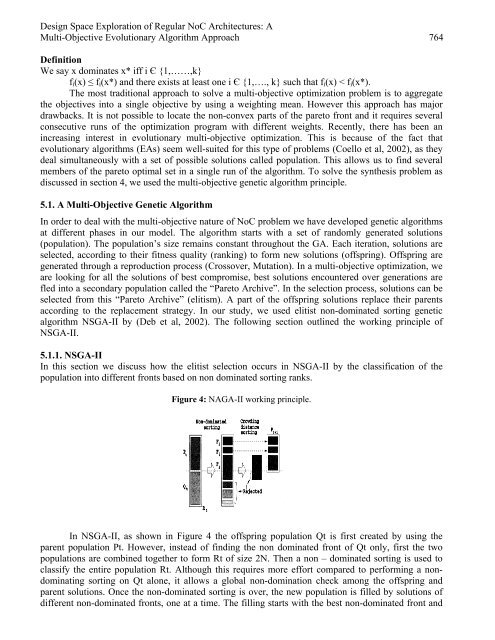European Journal of Scientific Research - EuroJournals
European Journal of Scientific Research - EuroJournals
European Journal of Scientific Research - EuroJournals
Create successful ePaper yourself
Turn your PDF publications into a flip-book with our unique Google optimized e-Paper software.
Design Space Exploration <strong>of</strong> Regular NoC Architectures: A<br />
Multi-Objective Evolutionary Algorithm Approach 764<br />
Definition<br />
We say x dominates x* iff i Є {1,……,k}<br />
fi(x) ≤ fi(x*) and there exists at least one i Є {1,…., k} such that fi(x) < fi(x*).<br />
The most traditional approach to solve a multi-objective optimization problem is to aggregate<br />
the objectives into a single objective by using a weighting mean. However this approach has major<br />
drawbacks. It is not possible to locate the non-convex parts <strong>of</strong> the pareto front and it requires several<br />
consecutive runs <strong>of</strong> the optimization program with different weights. Recently, there has been an<br />
increasing interest in evolutionary multi-objective optimization. This is because <strong>of</strong> the fact that<br />
evolutionary algorithms (EAs) seem well-suited for this type <strong>of</strong> problems (Coello et al, 2002), as they<br />
deal simultaneously with a set <strong>of</strong> possible solutions called population. This allows us to find several<br />
members <strong>of</strong> the pareto optimal set in a single run <strong>of</strong> the algorithm. To solve the synthesis problem as<br />
discussed in section 4, we used the multi-objective genetic algorithm principle.<br />
5.1. A Multi-Objective Genetic Algorithm<br />
In order to deal with the multi-objective nature <strong>of</strong> NoC problem we have developed genetic algorithms<br />
at different phases in our model. The algorithm starts with a set <strong>of</strong> randomly generated solutions<br />
(population). The population’s size remains constant throughout the GA. Each iteration, solutions are<br />
selected, according to their fitness quality (ranking) to form new solutions (<strong>of</strong>fspring). Offspring are<br />
generated through a reproduction process (Crossover, Mutation). In a multi-objective optimization, we<br />
are looking for all the solutions <strong>of</strong> best compromise, best solutions encountered over generations are<br />
fled into a secondary population called the “Pareto Archive”. In the selection process, solutions can be<br />
selected from this “Pareto Archive” (elitism). A part <strong>of</strong> the <strong>of</strong>fspring solutions replace their parents<br />
according to the replacement strategy. In our study, we used elitist non-dominated sorting genetic<br />
algorithm NSGA-II by (Deb et al, 2002). The following section outlined the working principle <strong>of</strong><br />
NSGA-II.<br />
5.1.1. NSGA-II<br />
In this section we discuss how the elitist selection occurs in NSGA-II by the classification <strong>of</strong> the<br />
population into different fronts based on non dominated sorting ranks.<br />
Figure 4: NAGA-II working principle.<br />
In NSGA-II, as shown in Figure 4 the <strong>of</strong>fspring population Qt is first created by using the<br />
parent population Pt. However, instead <strong>of</strong> finding the non dominated front <strong>of</strong> Qt only, first the two<br />
populations are combined together to form Rt <strong>of</strong> size 2N. Then a non – dominated sorting is used to<br />
classify the entire population Rt. Although this requires more effort compared to performing a nondominating<br />
sorting on Qt alone, it allows a global non-domination check among the <strong>of</strong>fspring and<br />
parent solutions. Once the non-dominated sorting is over, the new population is filled by solutions <strong>of</strong><br />
different non-dominated fronts, one at a time. The filling starts with the best non-dominated front and

















